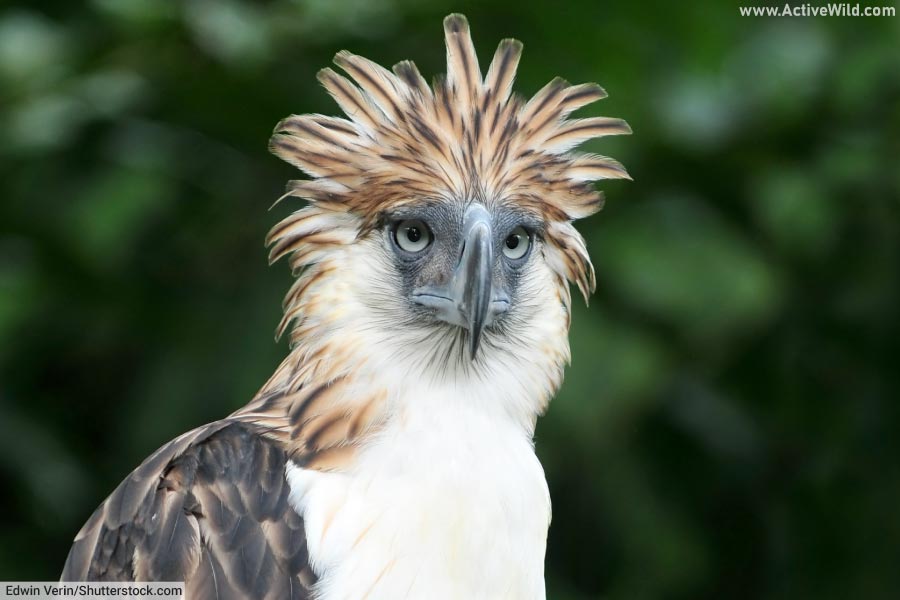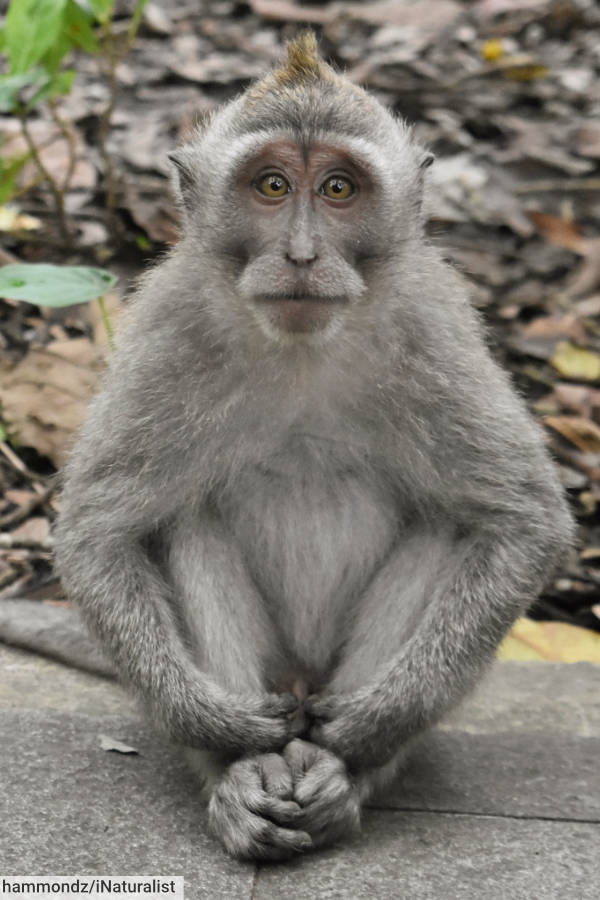Discover an apex predator, one of the largest of its kind, named by a dictator, and now facing extinction as one of the most endangered birds of prey.
Read on for a complete guide to the Philippine eagle…
Page Index
Introducing The Philippine Eagle…

The Philippine eagle is among the world’s largest birds of prey. This powerful apex predator is native to the Philippines, and is the island country’s national bird.
The Philippine eagle can be identified by its huge size, brown plumage, massive curved bill, powerful talons and in particular by its distinctive shaggy crest.
The species inhabits the rainforests of four of the 7,000-plus islands that make up the Philippines, and plays a crucial role in the forest ecosystem by maintaining the balance of species.
The Philippine eagle was once known as the “monkey eating eagle” on behalf of its diet, which includes large prey such as monkeys and similarly-sized animals. A 1978 proclamation by the Philippine’s then-President Ferdinand Marcos officially gave the bird its present name.
Sadly, this magnificent bird of prey is critically endangered due to habitat destruction and hunting, making its conservation a significant environmental concern.
You can see amazing images of the Philippine eagle in the video below (viewer discretion is advised, as the bird is shown with prey at some points in the film):
Philippine Eagle Stats
- Scientific Name: Pithecophaga jefferyi
- Order: Accipitriformes
- Family: Accipitridae
- Wingspan: 2.2 meters / approximately 7.2 feet
- Weight: 4.5 to 8 kg / 9.9 to 17.6 lb
- Where found: Endemic to the Philippines, primarily in the rainforests of Luzon, Samar, Leyte, and Mindanao
- IUCN Conservation Status: Critically Endangered
The World’s Largest Eagle?
The Philippine eagle is the world’s largest eagle in terms of body length and wing area, and the third-largest in terms of weight, after Steller’s sea eagle and the harpy eagle.
The wingspan of the Philippine eagle, despite reaching a huge 2.2 m / 7.22 ft., is proportionally slightly smaller than that of similarly-sized eagles – an adaptation for maneuvering through the dense rainforest canopy.
The Philippines
The Philippines is a Southeast Asian island country located in the western Pacific Ocean. It consists of 7,641 islands, the largest of which is Luzon. The country’s capital city is Manilla, and its largest city is Quezon City, both of which are located on Luzon. With a population of around 112,892,781, the Philippines is the world’s 12th most-populated country.
What Does A Philippine Eagle Look Like?

The Philippine Eagle is renowned for its majestic and imposing appearance. It has a body length typically ranging from 86 to 102 centimeters (34 to 40 inches) and has a robust and muscular build.
The wingspan of this magnificent raptor is particularly impressive, extending up to 2.2 meters (approximately 7.2 feet).
Weighing between 4.5 to 8 kilograms (9.9 to 17.6 pounds), the Philippine Eagle possesses considerable strength relative to its size.
The Philippine eagle’s plumage is predominantly dark brown with a creamy-white nape and underparts, and its powerful legs are yellow with large, sharp talons.
The most distinctive feature of the Philippine Eagle is its prominent crest of long, brown feathers that can be raised or lowered depending on mood or behavior.
The bird's large bill is a deep bluish-gray, adding to its fearsome appearance. The eagle's large eyes provide excellent vision for spotting prey from a distance.
Where Are Philippine Eagles Found?
The Philippine eagle is endemic to (only found in) the Philippines – an archipelagic country in the western Pacific Ocean. The bird is present on just four of the country’s 7,000-plus islands: Luzon, Samar, Leyte and Mindanao. Most of the bird’s population is found on Mindanao.
The eagle lives in tropical rainforests, typically inhabiting high forest canopies in steep terrain. It nests in large trees often situated near the forest edge, from which it can easily scout for prey.
Philippine Eagle Diet

The Philippine Eagle is a top predator in its forest ecosystem. It has a varied diet that primarily consists of small to medium-sized mammals and reptiles.
The eagle’s preferred prey includes the Philippine flying lemur, Asian palm civet, Malay civet, Northern Luzon giant cloud rat, crab-eating / long-tailed macaque, as well as various snakes, monitor lizards, and other small to medium-sized vertebrates.

Philippine Eagle Family And Related Species
The Philippine Eagle is the only member of its genus, Pithecophaga, and is part of the subfamily Circaetinae.
Many of the members of this subfamily are known as “snake eagles” or “serpent eagles” due to their specialty in hunting this type of prey. The Philippine eagle, however, is less specialized than its relatives.
Circaetinae is part of the family Accipitridae, which includes a diverse range of birds of prey such as hawks, eagles, and kites, encompassing over 240 species. The Accipitridae family is characterized by birds with sharp talons and hooked beaks, adapted for hunting and consuming other animals.
Philippine Eagle Life Cycle & Lifespan

The life cycle of the Philippine eagle begins with courtship, which involves elaborate and spectacular aerial displays, demonstrating the prowess and compatibility of potential mates. Once a pair bonds, they remain monogamous, often for life.
Nesting typically occurs in large trees high in the rainforest canopy, where the female lays a single egg every two years. The incubation period lasts for about two months, with the female responsible for the majority of the incubation.
After hatching, the eaglet is entirely dependent on its parents for food. The juvenile eagle grows rapidly, learning essential survival skills under the close guidance of its parents. It takes around five to seven months for the young eagle to fledge, although it may remain with the parents for a considerable time afterward, honing its hunting and flying abilities.
The lifespan of the Philippine Eagle in the wild is estimated to be around 30 to 60 years, although this can vary based on environmental conditions and threats. In captivity, where threats are minimized, these eagles can live up to 40 years or more.
Life expectancy in the wild is often shortened due to human-induced threats such as habitat destruction, hunting, and trapping. Female Philippine Eagles reach sexual maturity at around five years of age; males at seven.
The species’ low reproductive rate and the challenges it faces in its natural habitat means that every successful breeding cycle is vital for its survival.
Is The Philippine Eagle Endangered?
The Philippine eagle has the IUCN conservation rating “Critically Endangered”. This rating is given to the world’s most threatened species.
The Philippine eagle’s entire population is estimated to number under 800 individuals, a figure thought to be decreasing.
The Philippine eagle is endangered primarily due to habitat loss. Much of the Philippines’ rainforest has been destroyed by logging. Illegal hunting is another threat faced by the eagle, as well as accidental capture in traps meant for other species.
Philippine Eagle Film
The Cornell Lab of Ornithology have made an incredible film about the Philippine eagle, which is currently free to watch on YouTube:
Discover More With Active Wild
Visit our main animals page for links to animal information and a complete guide to the animal kingdom: Animals
- You can see more Asian animals on this page: Asian Animals
- You can see more rainforest animals on this page: Rainforest Animals List with Pictures & Facts
- You can find out more about birds on this page: Birds – The Ultimate Guide
- Discover different types of birds on this page: Types of Birds
- You can see more endangered animals on this page: Endangered Animals
- You can see more critically endangered animals on this page: Critically Endangered Species

